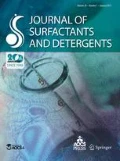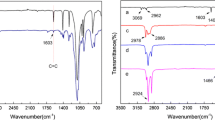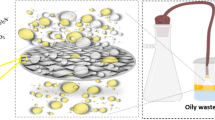Abstract
The adsorption of aroma chemicals on cotton fabric was studied relative to the surfactant concentration, surfactant type, water solubility, and fiber morphology. The adsorption increased with increasing surfactant concentration to a maximum near the critical micelle concentration, then decreased with further increases in surfactant concentration. The adsorption also was found to be highly dependent on the fiber surface area and pore structure; dramatic differences were observed between untreated and mercerized cotton fabric and are believed to be due to morphological differences. Cationic and anionic surfactants increased the aroma chemical adsorption, which varied with surfactant type, with cetyltrimethylammonium chloride (CTAC)>sodium dodecyl sulfate (SDS)>H2O. Water solubility also influenced adsorption; in most cases, adsorption increased with water solubility. In addition, adsorption was also influenced by chemical structure and hydrophobic interactions. The adsorption of aroma chemicals on cotton fabric can be attributed to the aqueous solution being physically held in capillaries and pore structures within the fibular structure of cotton fiber and also to molecular interactions among the aroma chemical molecules, surfactants, and cotton substrate.
Similar content being viewed by others
Abbreviations
- Cas :
-
concentration of aroma chemical in a stock aqueous solution
- CMC:
-
critical micelle concentrations
- Crs :
-
concentration of aroma chemical solution retained on cotton fabric
- CTAC:
-
cetyltrimethylammonium chloride
- GC:
-
gas chromatography
- MS:
-
mass spectrometry
- SDS:
-
sodium dodecyl sulfate
References
Escher, S.D., and E. Oliveros, A Quantitative Study of Factors That Influence the Substantivity of Fragrance Chemicals on Laundered and Dried Fabrics, J. Am. Oil Chem. Soc. 71:31 (1994).
Espinosa-Jimenez, M., and E. Gimenez-Martin, The Sorption of N-Acetylpyridinum Chloride on Leacril Fibers. Electrokinetic Properties, Acta Polymeric 47(4):181 (1996).
Reutenauer, S., and F. Thielmann, The Interaction of Cotton Fabrics and the Interaction with Perfume Molecules by Inverse Gas Chromatography (IGC), J. Mater. Sci. 38:2205 (2003).
Cantergiani, E., and D. Benczedi, Use of Inverse Gas Chromatography to Characterize Cotton Fabrics and Their Interactions with Fragrance Molecules at Controlled Relative Humidity, J. Chromatog. A 969:103 (2002).
Pusic, T., A.M. Grancaric, I. Soljacic, and V. Ribitsch, The Effect of Mercerization on the Electrokinetic Potential of Cotton, J. Soc. Dyers Colorists, 115 (4):121 (1999).
Stana-Kleinschek, K., S. Strnad, and V. Ribitsch, Surface Characterization and Adsorption Abilities of Cellulose Fibers, Polym. Eng. Sci. 39(8):1412 (1999).
Jacobash, H.J., I. Grosse, B. Thiel, B. Schmidt, and J. Schwertferger, Studies on the Preparation of Wet-Spun PAN Fibers. Part 1. Studies on the Sorption of Cationic Surfactants by PAN Fibers, Textiltechnik 32:176 (1982).
Nelson, R., and D.W. Oliver, Study of Cellulose Structure and Its Relation to Reactivity, J. Polym. Sci., Part C 36:305 (1971).
Obendorf, S.K., and J. Borsa, Lipid Soil Removal from Cotton Fabric After Mercerization and Carboxymethylation Finishing, J. Surfact. Deterg. 4:247 (2001).
Haigler, C.H., The Functions and Biogenesis of Native Cellulose, in Cellulose Chemistry and Its Applications, edited by T.P. Nevell and S.H. Zeronian, Ellis Horwood Ltd., West Sussex, England, 1985, p. 30.
Young, R.A., Structure, Swelling and Bonding of Cellulose Fibers, in Cellulose Structure, Modification and Hydrolysis, edited by R.A. Young, and R.M. Rowell, John Wiley & Sons, New York, 1986, p. 91.
Jellinek, J., and H.U. Warnecke, Fiber-Adherent Perfuming of Laundry Soft Rinses, Seifen, Oele, Fette, Wachse 102:215 (1976).
Liu, H., S.K. Obendorf, T.J. Young, and M. Incorvia, Microscopic Analysis of Aroma Chemical Distribution on Fibers. I. Cis-3-Hexenyl Salicylate, J. Appl. Polym. Sci. 91:3557 (2004).
Rybicki, E., and T. Paryjczak, Adsorption of Anionic Surfactants on Cotton, Tenside Deterg. 21:4 (1984).
Grancaric, A.M., T. Pusic, I. Soljacic, and V. Ribitsch, Influence of Electrokinetic Potential on Adsorption of Cationic Surfactants, Textile Chemist Colorist 29(12):33 (1997).
Madan, G.L., and S.K. Shrivastava, Electrokinetic Studies of Cotton. Part IV: Role of Water in Influencing Surface Charge Density of Cotton in Electrolyte Solution, Colloid Polym. Sci. 255:269 (1977).
Boesen, C.E., Bound Water in Cellulose, Cellulose Chem. Technol. 4:149 (1970).
White, H.J., Adsorption of Cationic Surfactants by Cellulosic Substrates, in Cationic Surfactants, Surfactant Science Series, edited by E. Jungermann, Dekker, New York, 1970, Vol. 4, p. 311.
Berg, J.C., The Role of Surfactants, in Absorbency, edited by P.K. Chatterjee, Elsevier, New York, 1985, p. 149.
Author information
Authors and Affiliations
Corresponding author
About this article
Cite this article
Liu, H., Obendorf, S.K., Leonard, M.J. et al. Adsorption of aroma chemicals on cotton fabric from aqueous systems. J Surfact Deterg 8, 311–317 (2005). https://doi.org/10.1007/s11743-005-0361-3
Received:
Accepted:
Issue Date:
DOI: https://doi.org/10.1007/s11743-005-0361-3




